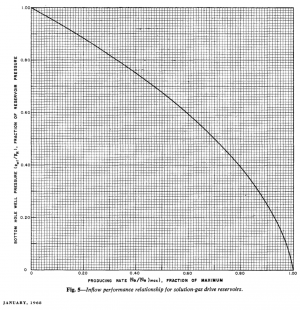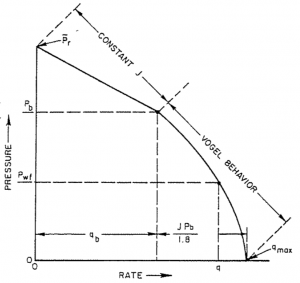Vogel's IPR
From wiki.pengtools.com
Contents
Vogel's Inflow Performance Relationship

Vogel's IPR[1]
Vogel's IPR is an empirical two-phase (oil + gas) inflow performance relationship correlation published in 1968 [1].
Vogel's IPR is based on computer simulations to several solution gas drive reservoirs for different fluid and reservoir relative permeability properties.
Vogel's IPR is the default IPR correlation to calculate oil wells performance in the PQplot nodal analysis software which is available online at petroleum engineering site www.pengtools.com.
Math and Physics
Vogel's IPR equation
Single phase liquid and Vogel's IPR
Combination Constant PI (Darcy's law) and Vogel's IPR
Why Vogel's IPR?
Vogel's IPR solution has been found to be very good and is widely used in prediction of IPR curves.— Kermit Brown et al[2]
Vogel's IPR calculation workflow
1. Calculate Productivity Index, J:
- 1.1 J from the flow test:
- Above the bubble point:

- Below the bubble point:
![J = \frac{q_o}{\bar{P}-P_b + \frac{P-b}{1.8} \left (1-0.2 \frac{P_{wf}}{\bar{P}} - 0.8 \left ( \frac{P_{wf}}{\bar{P}} \right )^2 \right ) }
:1.2 kh and [[JD]]
:1.3 kh and skin
== Nomenclature ==
:<math> B](/images/math/d/b/8/db810da885f38d8691e75a622cb9f2a0.png) = formation volume factor, bbl/stb
= formation volume factor, bbl/stb
- Above the bubble point:
 = dimensionless productivity index, dimensionless
= dimensionless productivity index, dimensionless = permeability times thickness, md*ft
= permeability times thickness, md*ft = average reservoir pressure, psia
= average reservoir pressure, psia = average reservoir pseudopressure, psia2/cP
= average reservoir pseudopressure, psia2/cP = well flowing pressure, psia
= well flowing pressure, psia = average well flowing pseudopressure, psia2/cP
= average well flowing pseudopressure, psia2/cP = flowing rate, stb/d
= flowing rate, stb/d = gas rate, MMscfd
= gas rate, MMscfd = temperature, °R
= temperature, °R
Greek symbols
 = viscosity, cp
= viscosity, cp
References
- ↑ 1.0 1.1 Vogel, J. V. (1968). "Inflow Performance Relationships for Solution-Gas Drive Wells". Journal of Petroleum Technology. 20 (SPE-1476-PA).
- ↑ 2.0 2.1 2.2 2.3 2.4 Brown, Kermit (1984). The Technology of Artificial Lift Methods. Volume 4. Production Optimization of Oil and Gas Wells by Nodal System Analysis. Tulsa, Oklahoma: PennWellBookss.
- ↑ Neely, A.B. (1976). Use of IPR Curves. Houston, Texas: Shell Oil Co.






